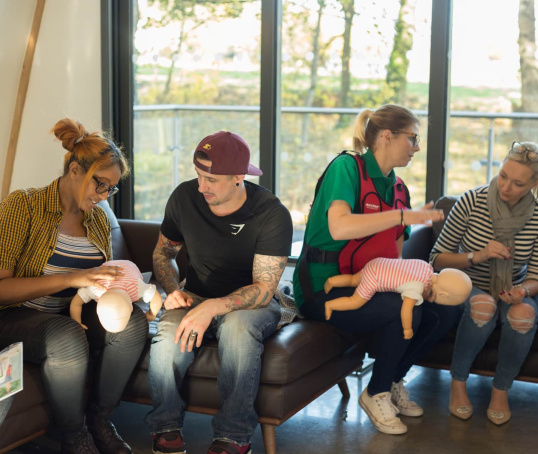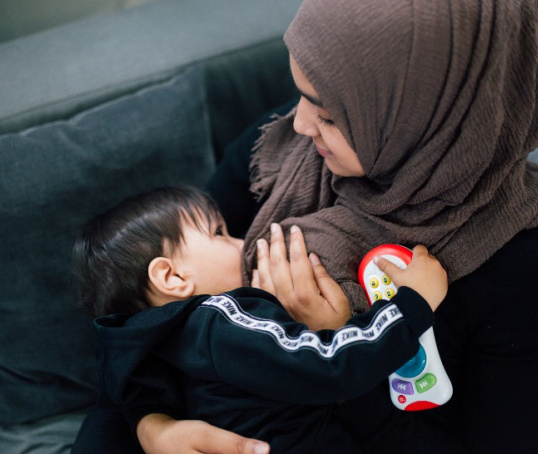How much bleeding is normal after birth and how long should it last? Learn about bleeding after having a baby and how to recognise if too much blood is being lost.
What amount of bleeding should be expected?
Everyone who has given birth will experience vaginal bleeding. This is called lochia (LOCK-ee-ur). The same amount of bleeding can be expected after a caesarean birth as after a vaginal birth.
Some of this blood comes from the place where the placenta was attached to the uterus. There might also be bleeding from a graze, tear or cut during the birth (RCOG, 2016).
The rest of the blood comes from the lining of the womb shedding, in the same way as a period.
Very absorbent pads should be used and changed regularly (NHS, 2024). The pads can also help the midwife know how much bleeding has happened by how many have been used.
What might be a cause for concern?
If the woman or birthing parent is losing clots larger than a 50p piece, they should tell their midwife (NHS, 2024).
Get medical help straight away if they:
- suddenly lose a lot of blood from the vagina
- feel faint
- have a rapid heartbeat
This could be a sign of a postpartum haemorrhage (NHS, 2024).
Also get immediate medical help if they have:
- a high temperature
- a sore and tender tummy
This could be a sign of sepsis (NHS, 2024).
Does breastfeeding make a difference to the bleeding?
Bleeding is redder and heavier just after breastfeeding or expressing milk, as breastfeeding makes the womb contract (NHS, 2024). However, the overall amount of blood will be the same if breastfeeding or not.
Stronger ‘afterpains’ cramps might also be felt while breastfeeding. Read our article about vagina and pelvic floor after birth.
Support from a breastfeeding counsellor can also be really beneficial. You can call our NCT breastfeeding counsellors on 0300 330 0700, every day from 8am to midnight.
How long will bleeding last?
The bleeding will be heaviest immediately after birth and lessen after a few hours. The first week might be like the heaviest days of a period and the blood will be bright red.
Over the following weeks it reduces and turns brown. It should have stopped by the time the baby is 12 weeks old (RCOG, 2016). Talk to the midwife if it isn’t reducing or stopping.
When will periods return?
Periods could come back 5-6 weeks after birth when formula feeding or mixed feeding. If exclusively breastfeeding and/or expressing, including at night, periods might not return until breastfeeding is reduced (NHS, 2024).
Is it safe to use tampons after giving birth?
Tampons or menstrual cups shouldn’t be used before the 6-8 week postnatal check. This is because of the risk of infection. Pads should be used instead (NHS, 2024).
Is sex possible while bleeding?
The woman or birthing parent can have sex if it feels comfortable, and they want to. Read more in our article about sex after birth.
Postpartum haemorrhage (PPH)
A postpartum haemorrhage (HEM-mor-ridge) is very heavy bleeding after birth. It can be Primary PPH or a Secondary PPH (RCOG, 2016).
Primary PPH
This is when a woman or birthing parent loses more than 500ml of blood in the first 24 hours after the baby is born. Losing more than 1000ml of blood is a major PPH.
Primary PPH might cause sickness or dizziness. A midwife will call for assistance straight away if the pregnant woman or person is in hospital. If they are at home or a midwife-led unit and unwell, they will be offered transfer to hospital. In most cases the bleeding will settle quickly with treatment, but it may mean a longer hospital stay (RCOG, 2016).
Primary PPH occurs in 1 in 4 births (NHS Digital, 2023a). However, it is at a different rate after different types of birth (NHS Digital, 2023b):
- Spontaneous vaginal birth: 18 in 100
- Planned caesarean birth: 26 in 100
- Unplanned caesarean birth: 34 in 100
- Vaginal birth with forceps or ventouse: 45 in 100
So as the national rate of interventions increases, so does the national rate of PPH.
Secondary PPH
This is heavy bleeding from 24 hours to 12 weeks after birth, usually after the woman or birthing parent has left hospital. It is often caused by an infection and might be linked to retained placenta (RCOG, 2016). It occurs in 2 in 100 postnatal women (Fox et al, 2023).
If someone loses a lot of blood after birth, they can become anaemic and extremely tired. It’s important to get medical help straight away if the mother or birthing parent is bleeding heavily. This helps prevent life-threatening blood loss (RCOG, 2016).
Contact the midwife or GP if the bleeding is getting heavier, the blood smells bad or the woman or birthing person doesn’t feel well. They might need antibiotics for the infection (RCOG, 2016).
If heavy bleeding doesn’t stop, the mother or birthing person might need to go to hospital for further treatment (RCOG, 2016).
To find out more about PPH read the RCOG patient information.
Does PPH affect breastfeeding?
Significant blood loss can affect breastfeeding and milk supply. This is partly because the mother or birthing parent and baby are likely to be separated for medical procedures. The loss of blood can also affect the release of hormones to stimulate milk production.
The clinician and partner may also be anxious to prioritise rest for the woman over supporting breastfeeding or expressing (Flood et al, 2023; Henry & Britz, 2013). It is important that the mother continues to receive support with expressing or breastfeeding if that is what they want (Flood et al, 2023).
When this happens, skin-to-skin contact with the mother could be offered when the bleeding is controlled (Flood et al, 2023). Read our article on skin to skin to understand why skin-to-skin is important.
Further Information
Find out more about life after you've given birth on our NCT New Baby course. It supports new parents and their babies, leaving you feeling confident, knowledgeable and relaxed.
Flood, MM. et al. (2023) Primary postpartum haemorrhage adversely impacts breastfeeding initiation in Victoria, Australia. Women and Birth, 36 (6), e582 – e590. https://doi.org/10.1016/j.wombi.2023.05.001
Fox R, Aitken G, Mooney SS, (2023) Management of secondary postpartum haemorrhage: A systematic review, European Journal of Obstetrics & Gynecology and Reproductive Biology. 282, pp116-123. https://doi.org/10.1016/j.ejogrb.2023.01.023
Henry L, Britz SP (2013) Loss of Blood = Loss of Breast Milk? The Effect of Postpartum Hemorrhage on Breastfeeding Success. Journal of Obstetric, Gynecologic & Neonatal Nursing, 42, Supplement 1, S100. https://doi.org/10.1111/1552-6909.12198
NHS (2024) Your body after the birth. https://www.nhs.uk/pregnancy/labour-and-birth/after-the-birth/your-body/ [11 Nov 24]
NHS Digital (2023a) NHS Maternity statistics, England, 2022-23. Summary report tables. https://digital.nhs.uk/data-and-information/publications/statistical/nh… [11 Nov 24]
NHS Digital (2023b) NHS Maternity statistics, England, 2022-23. HES NHS maternity statistics tables. https://digital.nhs.uk/data-and-information/publications/statistical/nh… [11 Nov 24]
RCOG (2016) Heavy bleeding after birth (postpartum haemorrhage). https://www.rcog.org.uk/for-the-public/browse-our-patient-information/h… [11 Nov 24]






